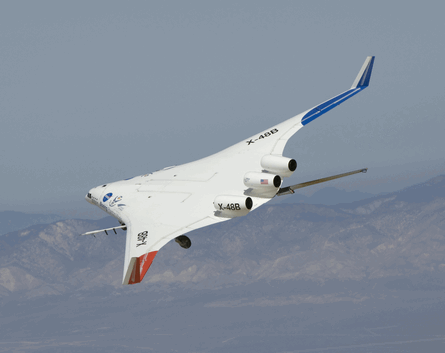Boeing has completed the first in a series of increasingly risky envelope expansion flights for the X-48B blended wing body (BWB) demonstrator.
The first 11 "Block 1" flights completed last year used fixed leading edge slats to allow for lower airspeeds and greater control on approach to landing.
Since 4 April, Boeing has flown three Block 2 flights with the leading edge slats removed, boosting speeds by 15kt (28km/h) to 20kt on take-off and landing.
"Everything gets a lot more sporty," says Mike Kisska, Boeing's X-48B project manager.
 |
|---|
© NASA/Carla Thomas |
The first two flights in Block 2 featured a mid-fuselage centre of gravity to test responses by the flight controls. Boeing also has flown the first of two more Block 2 tests featuring a forward CG configuration.
The second forward-CG flight was scheduled for 22 May, but was scrubbed because of high winds and other atmospheric disturbances at the X-48B test range on Edwards AFB, California.
The one-eighth scale X-48B, which precisely simulates a BWB with a 240ft (75m) wingspan, is highly susceptible to wind conditions. A 10kt gust is equivalent to a 35kt crosswind for the X-48B on approach, limiting test flights to calm days in the California desert, Kisska says.
Boeing and the NASA Dryden Research Center plan to complete four more blocks of flight tests by the end of the year. The next two blocks will focus on the aircraft's performance in stall conditions. In the last two blocks, Boeing will attempt to throw the unmanned X-48B at the flight control limiters, observing its response to crossing envelope-protection algorithms.
To help speed up the flight-test phase, Boeing has approved a project to integrate a 45lb-thrust (0.2kN), ducted-fan version of the JetCat SPT5 turboprop on the aircraft. Replacing one of the X-48B's three turbojets with a ducted fan will reduce fuel burn by 15%, giving the aircraft more time to complete test points in flight.
The X-48B's aerodynamic tests are due to expire by the end of the year, but the aircraft may pick up a second career as a flying testbed, Kisska says.
NASA is interested in using the X-48B as a testbed next year for an adaptive flight controls test programme. With 20 different flight control surfaces, the X-48B airframe makes an ideal testbed such tests, he says.
Source: Flight International



















